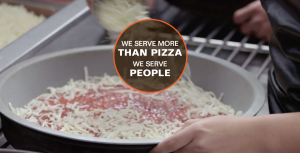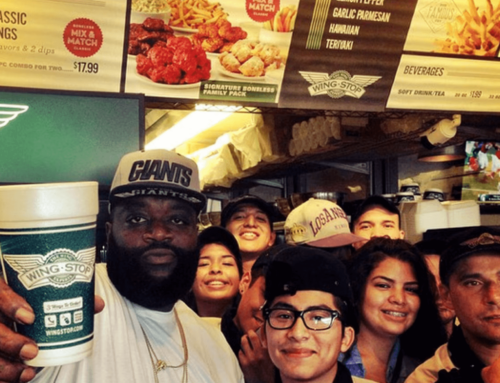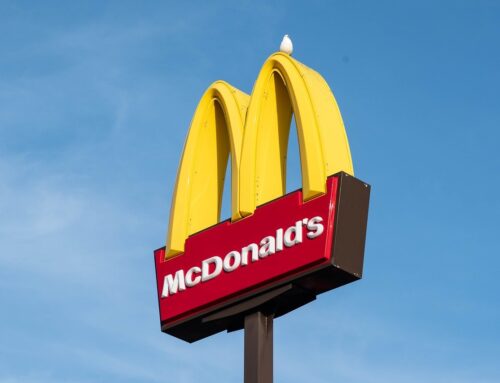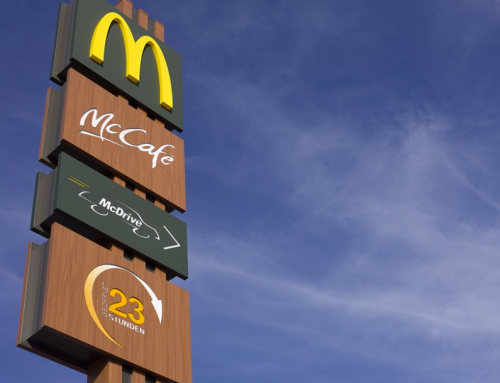After operating expenses, the average Little Caesars franchise owner will bring in $50,000 to $200,000 each year. It’s tough to calculate a franchisee’s “typical income” since there are many factors that contribute net profits like location, marketing skills, customers service, and food waste. But I want to offer up a simple ball-park figure as an estimate.
On average, it will cost $360,000 all the way up to $1.6 million to open a Little Caesars location. Keep in if you plan to open the restaurant in a market with above average commercial real estate prices (I’m looking at your California), you could end up closer to the higher end of the investment scale.
Still, Little Caesars is able to keep startup cost low thanks to a stripped-down operating model that doesn’t require a large dining room with seating and can be operated out a tight retail space between 1,200 – 1,600 square feet in size. This is smaller footprint than competitive concepts require. You can also take our 8-minute franchise quiz to find out if Little Caesars is a good fit for your personality and experience.

Youth hockey team diving into a Little Caesars pizza delivery.
Financial Requirements and Fees
Little Caesars has proven to be a wise investment in the pizza industry. For operators looking to make an impact with an uncomplicated business model, world-class service, and millions of loyal consumers make this a franchise worth evaluating.
Determined to break into the franchise business, but low on cash? Individuals can even team up with a partner to invest in a franchise and take advantage of combined net worth and liquidity. This is a model to consider if you’re low on funds, but eager to work inside the business on a day-to-day business. Believe it or not, there are plenty of investors out there that have an access of cash, but don’t want to spend their time working at a pizza shop. Food for thought.
The following are the expenses and fees corresponding with opening a new Little Caesars:
|
Type of Fee |
Low |
High |
| Startup Franchise Fee | $20,000 (normal fee); $15,000 in certain cases | |
| Beginning Inventory and Supplies | $63,000 | $154,000 |
| Licenses and Permits | $1,000 | $20,000 |
| Grand Opening Promotions | $12,000 | $20,000 |
| Fixtures, Equipment and Signage | $186,000 | $392,000 |
| Rental | $1,500 | $7,000 |
| Leasehold Improvements | $50,000 | $1,000,000 |
| Training Costs | $12,000 | $16,500 |
| Insurance | $1,200 | $2,000 |
| Additional Funds – 3 months | $17,000 | $47,000 |
| Utility Expenses | $1,000 | $7,500 |
| Projected Total Expenditures | $359,700 | $1,686,000 |
Financial Requirements
Let’s take a look at the startup costs associated with this pizza chain. Little Caesars provides franchisees with an established business plan to assist them in serving affordable pizza with a no-contact options.
|
Requirement |
Fee |
| Liquid Capital | $150,000 |
| Net Worth | $350,000 |
| Total Investment | Starting at $360,000 |
| Franchise fee | $20,000 (regular rate); $15,000 in certain cases |
Little Caesars’ franchise fee is normally at $20,000, but specific circumstances allow for a reduction to $15,000 if you qualify. A typical Little Caesar franchise requires a total investment of $359,700 (roughly $360,000) to $1,686,000 to get up and running. Franchisees must settle a weekly royalty of at least 6% of total sales for the week, or $100. Franchisees must contribute 7% of gross sales to the franchisor’s advertising budget in order to participate in national advertising. These fee covers the cost of national television, radio, online, direct mail, and even coupon marketing efforts.
Before investing in this concept make sure to request an updated Franchise Disclosure Document from the company. This is a report that must be provided to prospective franchisees so they understand the risks and potential of the business. Despite the fact that this section of the Franchise Disclosure Document, known as Item 19, is not mandated by law, it is uncommon for a well-established franchisor to withhold financial performance statistics from potential investors.
Related Reading: 63 New World Pizza Industry Statistics and Consumer Trends
One important thing to point out is the growth of Little Caesars’ franchise outlets throughout the United States appears to be mostly driven by company-owned locations rather than franchises. Moreover, 23 franchised units were discontinued in 2020 for various reasons, while 21 corporate-owned units were incorporated into the company. On closer examination of their FDD indicates that 15 of the newly launched company-owned locations were repurchased from franchisees.
While there may be a variety of explanations for this tendency, one possibility is that Little Caesars is diverting resources away from franchise development and focusing them instead on internal expansion. This is purely speculation, however.
How Much Profit Does Little Caesars Franchisees Make Per Year?
Company revenue/sales per year: For the fiscal year ending 2020, Little Caesars’ global sales were at $4,725,000,000 representing a 3.3% growth in total sales.
Number of units: Little Caesars has 5,361 units across the globe as of 2021. Most of these (4,211 units) of which are located in the United States, while 1,150 units operate internationally.
Average Gross Revenue Per Store: $4,725,000,000 (System-wide sales) ÷ 5,361 units = $881,365.
Industry Average Profit Margin: Clearly, the real profit margin will be determined by a variety of factors. A few years ago, it was estimated that the average profit margin of the pizzeria sector was at 8%, which meant that for every $10 pizza bought, you could only earn around 80 cents. Imagine if someone paid $25 for a pizza pie, only $2 was returned to the bank.
Inflation is at an all-time high right now. Since prices have risen, we may have to spend a little extra on pizza nowadays. It’s no wonder that selling beverages and drinks is where most restaurants make their serious cash. Because some pizza joints are permitted to offer beer, that’s where they make the most money. Today, a median pizza profit margin is believed to be as high as 15%, which is thought to be pretty reasonable. Due to supply chain and optimization of cooking processes of Little Caesars over the years the profitability could be even higher.
The food sector is a cutthroat business. Hundreds of pizza joints can be found around the United States. Depending primarily on the locale, a pizza profit margin could be different. A small cheese pizza, according to some pizza producers, costs roughly $1.50. And this is only after the ingredients are counted. Certain costs, such as labor, taxes, and lease payments aren’t always included in overhead estimates.
So how much would a small cheese pizza cost to make? This number, of course, varies from chain to chain. Some pizza restaurants use only the best artisan ingredients, whilst other pizza joints buy in bulk and negotiate discounts with suppliers. You can bet Little Caesars has some competitive advantages in this department.
Projected Annual Profit Per Store:

What’s the Failure Rate of Little Caesars?
Only 3% of new franchisees fail within the first year of operation with a Little Caesars. Little Caesars, like some of its competitors like Domino’s Pizza have a similar failure rate hovering around 2% annually.
A certain number of annual failures is to be expected for a large franchise business with thousands of units. Even the global powerhouse McDonald’s with more than 38,000 units in more than 100 countries has locations that go out of business each year for a variety of reasons. Sometimes franchise business failures happen due to nothing more than the decline in the economy of a certain town or city. Business closures don’t always have anything to do with the underlying performance of a business and can occur simply because an operator decides to retire. In many cases these operators are able to sell the business to a new owner.
Little Caesars SWOT Analysis
Little Caesars’ SWOT analysis examines the company’s strengths, weaknesses, opportunities, and threats. Little Caesars is a well-known brand in the foodservice industry, particularly in the fast-food pizza chain market. A SWOT analysis is a tried-and-true management methodology that allows a company like Little Caesars to evaluate its operations and progress against that of its rivals.
Strengths
- Quick Serve and Simple Menu. With the advent of their Hot-N-Ready pizza offer, Little Caesars defied convention by producing pizzas fresh when customers walked in, eliminating the need to order beforehand or wait in line. The $5.55 for a Hot-N-Ready pizza (recently increased by 11 percent after nearly 25 years). Little Caesars was the first pizza restaurant to provide lunch service, a drive-thru, and pizza delivered in minutes. I’ve enjoyed picking up their pre-made pepperoni pizza many times in the past.
- Established brand. Little Caesars is a popular American fast food business known for its motto “Pizza! Pizza!” which was first used in 1979. Since its inception in 1959, it has built a strong brand name.
- Low Cost, Low Effort Add-ons. Little Caesars has been able to increase their average ticket value without creating additional work for their employees. One example is their variety of pre-made sauces and dips like ranch dressing or a garlic sauce that come in packets and are sold between $1 – $2. There also offer to-go bottles and cans of soda or water than can be purchased.
- Global brand recognition. Little Caesars is not just a local pizza powerhouse, in fact, it is one of the biggest carry-out pizza chains in the world. As of 2020, Little Caesars has 1,150 units outside of the United States which comprise 21% of its total business.
- Innovative promotions. Little Caesars’ innovative advertising and marketing initiatives have aided the company’s rapid growth. They also made the “buy one, get one free” approach a staple of fast food promotion.
Weaknesses
- Decreased profits. When Little Caesars tried to offer free delivery, their profitability plummeted, forcing a huge number of franchisees to close their doors. As mentioned earlier, about 23 franchised units were discontinued back in 2020 for various reasons and one of them would be declining profits which made them believe that the business wasn’t viable anymore. These input challenges are factors that all pizza chains are facing.
- Franchise management. For Little Caesars, franchise management could be a problem. There have been reports that some managers had taken it on themselves to operate their business in violation of company policy. This lack of connection between the corporate office and the franchisees can spell trouble in dealing with day-to-day operations.
- Limited Offerings. Limited menu options and a lack of focus on the taste and quality of their pizzas, as well as no delivery options, can also be considered as one of the company’s weaknesses. When the Covid pandemic hit the world last 2020, most food and beverage businesses turned to delivery as a way to survive the economic turnaround. Their incapability to improve on their ingredients and taste would also indicate trouble, especially in this industry due to the presence of a large number of players.
Opportunities
- Product development. We all know that Little Caesars is known for their fast, Hot-N-Ready 12” pizzas as well as their limited pizza flavor range. Compared to their rivals such as Pizza Hut which has a wider range of pizza flavors as well as other offerings such as pasta and several beverages. Little Caesars can focus on product development and create new exciting pizza flavors and other offerings in order to compete with their other well-established rivals.
Related Reading: 181+ Brilliant Pizza Loving Captions and Quotes for Social Media
- Online ordering. Currently, Little Caesars ONLY offers pick up and delivery for your pizza orders. The company needs to expand this into online ordering, especially after the pandemic which stalled many food and beverage companies due to local lockdowns and limited movement of people. Though we’re going over the hump in this pandemic after 2 restless years, it may be time for Little Caesars to consider online ordering to remain competitive in the fast-food pizza industry.
Threats
- Healthier lifestyle. Nowadays, people are more conscious about their health, especially the millennials, and maybe looking into healthier alternatives in their diet. Pizza is considered as one of those foods that are not considered healthy along with burgers unless these are made with alternative ingredients such as plant-based patties in burgers. Unless they offer pizzas with healthier ingredients, a considerable percentage of their customers might turn away and look for healthier alternatives in getting their pizza craving.
- Declining profit margin. Rising prices for specialty components such as cheese used in pizzas, especially in the aftermath of the pandemic, could result in decreased profit margins for the company. Decreased profits could again result in certain outlets being in danger of shutting down which could result in scaling down of the business.
Is Little Caesars Worth the Cost to Invest?
You taking the right approach before investing in a franchise by doing your research. Fortunately, Little Caesars is getting a lot of things right. There will always be demand for affordable pizza even in recessionary times.
In spite of a proven business model, the pizza chain isn’t resting on its laurels. Little Caesars Pizza, in fact, has been crowned “Best Value in America” for the past 10 years, and with it, the brand resonates with customers on multiple levels thanks to their consistent innovation and value promise.
Little Caesars offers prospective franchisees with resources they would need in order to implement the brand’s proven model, such as ongoing training, architectural services to support construction and design, ideal lending institutions to facilitate financing, ongoing product development, and research, as well as clever marketing programs.

We serve more than pizza.
The main downside to find out would be to understand why 23 franchised units were shut down in 2020. The more specific information you can gather on this subject the better. There could be various factors at play here since there were 21 company-owned units that were added the very same year. I would also try to understand why the company is opening more company operated units. Is the corporate office keeping the most profitable locations? These are questions worth asking and thinking about.
Little Caesars isn’t the 3rd largest pizza chain in America based on sales for nothing. Despite some setbacks in the previous years of closing down several outlets, Little Caesars remains to be one of the top players in the industry.
Is Little Caesars Less Expensive for Veterans?
Little Caesars not only provides free lunch to veterans and active service military members on Veterans Day, they also assist veterans in opening their very own Caesars franchise. Mike Ilitch, the creator of Little Caesars, honorably served in the US Marine Corps during the Korean War, founded the Veterans Program in 2006. Ilitch’s goal was to help fellow service veterans create entrepreneurial opportunities.
Now in its 15th year, the Little Caesars Veterans Program offers economic incentives to honorably discharged veterans and Gold Star families who want to create their own Little Caesars franchise. Honorably discharged veterans and Gold Star families who launch a franchise store can take advantage of the Veterans Program, which includes a franchise fee reduction, supply and equipment discounts, financial aid, and advertising and marketing support, among other things. Hundreds of Little Caesars restaurants are now operated by veterans across the United States.
The History of Little Caesars
Little Caesars Enterprises Inc., or simply Little Caesars, is a multi-national pizza company based in the United States. Little Caesars, behind Pizza Hut and Domino’s Pizza, is the third-largest pizza chain in the United States by total sales, according to 2020 figures. It owns and runs pizza franchises across the United States as well as Asia, the Middle East, Canada, Latin America, and the Caribbean. The company was established back in 1959 and is located in the Fox Theater building in Detroit, Michigan.
Related Reading: 211 of the World’s Greatest Pizza Slogans and Quotes List
Mike Ilitch and his wife Marian Ilitch established Little Caesars Pizza on May 8, 1959. “Little Caesar’s Pizza Treat” was the name of the first restaurant, which was located in a strip mall in Garden City, Michigan, a suburb of Detroit. In October of 2018, the original store closed. Little Caesar’s Pizza Treat was the name of the first Little Caesars franchise store, which debuted in Warren, Michigan, in 1962. Little Caesar’s emblem was turned into a three-dimensional figure and utilized on outdoor signage the same year.
The catchphrase “Pizza! Pizza!” was first used in 1979 and has become synonymous with the brand. The expression refers to a competitor offering two pizzas for the same price as a single pizza. The pizzas were originally presented in a single, long container (a corrugated cardboard box arranged into a 2-by-1 orientation, containing two square pizzas situated side by side, then slid into a form-fitting paper sleeve that was folded and stapled closed). Little Caesars has already moved away from the awkward packaging and replaced it with standard pizza boxes. Shrimp, fish, chicken, and Hot dogs were available in addition to pizza with “strange” toppings.
Who owns Little Caesars?
Ilitch Holdings, Inc., an American holding company owned and established by Mike and Marian Ilitch, owns Little Caesars along with other professional and technical services companies under this umbrella organization.
These other companies include the Detroit Red Wings of the National Hockey League (NHL), the Detroit Tigers from the Major League Baseball (MLB), Olympia Development, Olympia Parking, Olympia Entertainment, Champion Foods, Blue Line Foodservice Distribution, the Little Caesars Pizza Kit Fundraising Program, Hockeytown Cafe, 313 Presents, and a variety of venues within these entities. Ilitch Holdings subsidiaries manage Comerica Park, Detroit’s Fox Theatre, DTE Energy Music Theatre, City Theatre, Meadow Brook Amphitheater, the Little Caesars Arena, Michigan Lottery Amphitheater, and Joe Louis Arena (now closed).
To find out if Little Caesars is the right franchise business for you, take our 8-minute franchise quiz. We will match you with the best opportunities based on personal interests, industry, financial requirements, and location.




